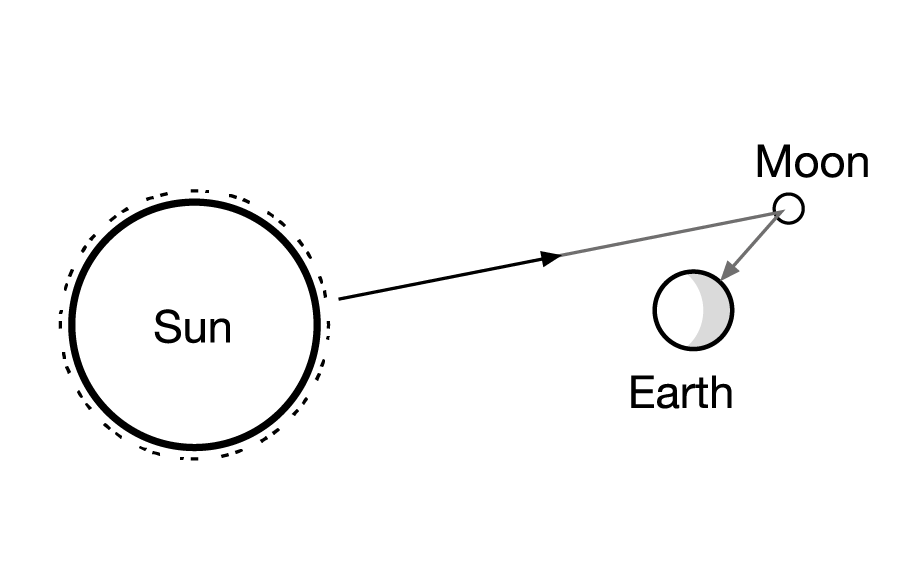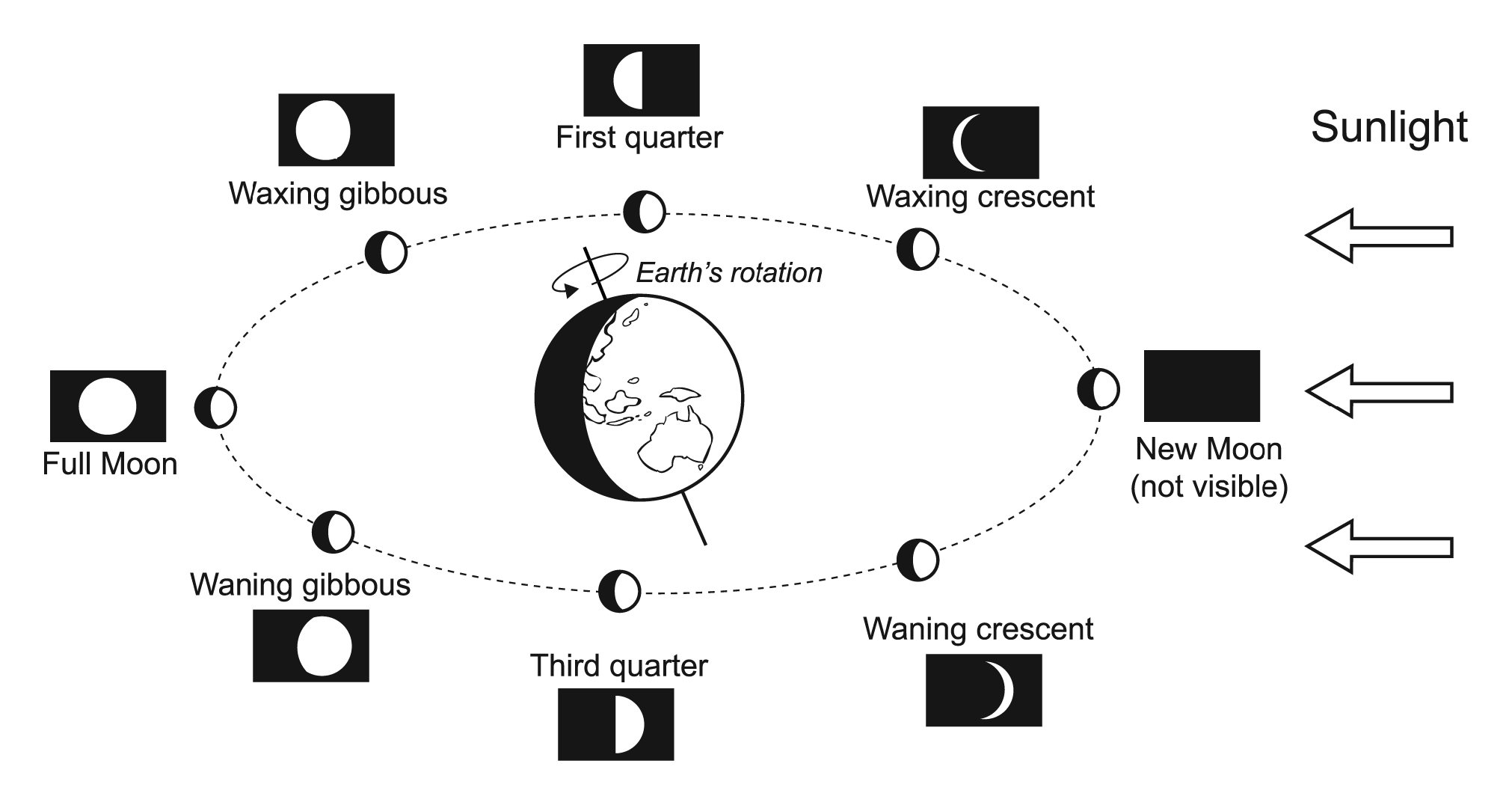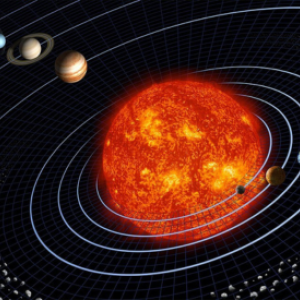The Solar System
The Sun, Earth and Moon belong to our Solar System, which includes all the space objects—planets, moons, comets and particles of dust—that are in orbit around our Sun.
A ‘space object’ (or celestial body/heavenly body/space body) refers to naturally occurring objects in space, such as planets, asteroids and comets. Space objects in the Solar System are visible because light from the Sun reflects off them to reach our eyes.
The whole Solar System is moving at great speed through the Galaxy. Our Solar System is part of the Milky Way Galaxy, which contains tens of billions of stars. The universe comprises billions of galaxies.
Stars
Stars are space objects and some are similar to our Sun. They are much further away—the light from the nearest star takes more than four years just to reach us, whereas the light from the Sun takes eight minutes. The light from distant stars, therefore, appears to be not as bright in the sky as the Sun, which is why stars cannot be seen during the day. Sometimes the first ‘star’ to be seen at dawn or dusk is in fact the planet Venus, reflecting light back from the Sun to our eyes.
The stars appear to be in groups, which we call constellations. Different cultures have named some star groups as constellations, based on their mythology. People observed that during the night different constellations passed overhead, and some constellations were more visible at different times of the year. Different cultures have used this observation to track time and/or have explained the patterns in the sky through myths and legends. Some of these myths and legends link the events in the sky to seasonal events at the Earth’s surface.
Planets are kept to their orbits around the Sun by the force of gravity between them and the Sun. The further a planet is from the Sun, the longer it takes to go once around the Sun (its year). The four inner planets (Mercury, Venus, Earth and Mars) consist of dense rocky material. The four outer planets (Jupiter, Saturn, Uranus and Neptune) are collections of gases and are much less dense. Earth is the only planet to have liquid water at its surface.
Moons of planets are kept in orbit by the planets’ gravity. Mercury and Venus do not have moons; Saturn and Jupiter have dozens. Saturn and Uranus have rings made of a huge collection of small orbiting fragments. Generally, moons are made of rock and have little or no atmosphere. However, some moons of gas planets, for example, Jupiter, are very large and are almost like small rocky planets themselves. There are more than 160 known moons in the Solar System.
Between Mars and Jupiter there is a belt of asteroids that orbit the Sun. Asteroids are smaller, rocky space objects. Some are quite large and have other asteroids orbiting them. The largest asteroid, Ceres, has been classified as a dwarf planet, similar to Pluto. Beyond the last planet, Neptune, there is another ring of small bodies similar to the asteroid belt, called the Kuiper belt. Space objects within the Kuiper belt are rocks and ice objects. Three of the larger bodies within the Kuiper belt—Pluto, Haumea and Makemake—are currently classified as dwarf planets. The Solar System also includes human-made objects, such as space probes (robotic spacecraft sent to collect information), space stations and satellites.
Sun
The Sun is a rather ordinary star in an immense galaxy, the Milky Way, which contains about 100,000 million stars. Our galaxy is shaped like a flat spiral, and our Sun is about two-thirds of the way out from its centre. The galaxy is so immense that light takes about 100,000 years to cross it. Our galaxy is only a tiny part of the universe. The estimated number of galaxies out to the edge of what we can see with our largest telescope is about 100,000 million.
The Sun is approximately 70% hydrogen gas, which undergoes constant nuclear fusion to produce helium at its core and release energy as visible light and heat. Because the Sun is so massive, everything else in the Solar System is attracted to it by the Sun’s gravity and everything revolves in orbit around it.
The Sun is a medium-sized star that is in the middle of its life cycle (4.6 billion years old). The Sun is always heating and lighting the Earth, but only the side of the Earth facing the Sun experiences daylight. The rest is in shadow. The reason we experience alternating night and day, or the apparent rising and setting of the Sun, is that the Earth is spinning on its axis, once every 24 hours.
Earth
The Earth is a planet in orbit around the Sun. This orbit takes slightly more than one year—365¼ days—so we add an extra day to our calendar, 29 February, in every fourth year, which we call a leap year.
As the Earth slowly orbits the Sun, it rotates on its axis once every 24 hours (a day). The rotation of the Earth causes the apparent rising and setting of the Sun and is the reason we experience alternating night and day.
The Earth is the only habitable planet in the Solar System and, as far as we know, in the universe. The Earth’s atmosphere contains oxygen, which is necessary to support life. It also contains carbon dioxide, which acts like a blanket, keeping the Earth at a temperature that will support life. Earth is also the only planet in the Solar System with liquid water on its surface.

Earth and its moon
For a long time, the Earth was thought to be flat, because that is how it appears to an observer standing on the ground. Because of the Earth’s immense size, it curves over large distances, which makes it nearly impossible to observe its curvature with the naked eye.
In the fourth century BC, Aristotle proposed that the Earth was round, based on three observations. Firstly, ships sailing away from land appeared to vanish hull-first into the ocean as they sailed into the distance. If the Earth was flat, we would expect these ships to get smaller and smaller until they disappeared. Secondly, the further south a person travelled, the higher the southern constellations rose in the night sky, meaning the person’s angle of view was changing, which is not possible on a flat disc. And thirdly, the shadow of the Earth on the Moon during a lunar eclipse was always a circle, and only a sphere always casts a circular shadow.
Moon
The Moon is a satellite of the Earth. It is held in orbit by the Earth’s gravity and goes around the Earth relatively quickly because it is close to the Earth. The Moon’s gravitational pull on the Earth is not nearly as strong as the Sun’s, because the Moon is less massive, but it is enough to draw the Earth’s oceans towards it and cause the tides.

On Earth we only see one side of the Moon.
We always see the same face of the Moon from Earth, because the Moon spins on its axis once each time it goes around the Earth. The Moon is made of rock and has virtually no atmosphere. The Moon itself does not produce light; we can see it from the Earth only because the Moon reflects light from the Sun.

The Moon reflects the light from the Sun
Sun, moon, planets and stars
Day and night
Night and day are the result of the Earth spinning on its axis. The Earth makes one complete rotation on its axis approximately every 24 hours. The side of the Earth facing the Sun is in daylight, while the side facing away is in the Earth’s own shadow (night). Although the Sun appears to move across the sky during the day, it is not movement by the Sun but the Earth’s rotation that causes the apparent movement of the Sun across the sky. The Earth spins in an anti-clockwise direction when viewed from the North Pole, so that the east coast of Australia moves into the sunlight first in the morning and sunrise is experienced two or three hours later (depending on daylight saving) on the west coast.
The Earth's rotation can be illustrated through the movement of shadows. A shadow stick can be any tall, narrow object that can be set up vertically. In the early morning, as the Sun appears to rise in the East, the stick will cast a long shadow towards the West. In the late afternoon, as the Sun sets in the West, a long shadow will point eastwards.
If the length and direction of the shadow are marked at regular intervals throughout the day, the shortest shadow can be determined; this occurs at solar noon. Solar noon is the time of day, halfway between sunrise and sunset, when the Sun is at its highest point in the sky. This might not be at 12 noon as solar noon is usually different from clock noon because of artificial time zones and daylight saving arrangements.
At sunset, daylight gradually decreases until there is no light to illuminate objects for us to see. We say it is dark at night because there is an absence of light. If the Moon is in a position where it is fully or partially illuminated by the Sun, we will see it at some time during the night and will experience some objects illuminated by moonlight. We can see stars gradually seem to appear as darkness falls. They are always present in the sky but the Sun’s brilliant light blocks the more distant starlight during the day, so they seem to disappear. The stars produce their own light and ‘twinkle’ because they are tiny points of lights that are affected by their passage through the Earth’s atmosphere by turbulent winds. Some of our solar system’s planets are also visible at night. Venus and Mars are easy to spot with the naked eye. They reflect light from the Sun and are big enough that the effects of the atmosphere cannot normally be seen and they do not ‘twinkle’. The planets change their positions in relation to Earth as their own orbits progress around the Sun.
Moon phases
The Moon also rises in the east and sets in the west, but at different times to the Sun because the Moon revolves around the Earth once per month. Sometimes the Moon is on the same side of the Earth as the Sun, and we will see it rise and set during the day. When it is on the opposite side of the Earth from the Sun, the Moon will rise at night and set in the morning. The Moon also rotates on its axis once per month. The result is that we only see one side of the Moon from Earth.
The Moon cannot produce its own light but is visible when it reflects light from the Sun to Earth. We see the Moon’s phases because we only see the part of the Moon that is illuminated by the Sun. When the Moon is in a position in relation to the Earth and Sun where its whole face is illuminated, we see a full moon at night. When the Moon is on the same side of the Earth as the Sun, we will see a new or crescent moon, with very little of its face to Earth illuminated. During the rest of its revolution around the Earth we will see differing amounts of the Moon illuminated at differing times of the day and night. This pattern repeats itself approximately every 27.3 days.

The moon phases are a result of position of the Sun (and not the shadow of the Earth).
Summer and winter
The Sun itself will change position in relation to its observers on Earth and appear to move in an arc across the sky from east to west. This arc will vary in height depending on the season, due to the tilt of the axis of rotation of the Earth relative to the plane of its orbit around the Sun and its position as it revolves around the Sun. In summer the Sun’s rays are more direct and the arc is higher in the sky. In winter the rays are more angled and the arc is lower in the sky.
Earth is part of an astronomical system; interactions between Earth and celestial bodies influence the Earth system.
This list of alternative conceptions is not meant to be comprehensive, but instead aims to provide a starting point.
Alternative conception | Accepted conception |
| Air is weightless or has negative weight. | Air has mass and can be affected by gravity. Therefore, air has weight. |
| There is air between air particles/molecules. | There is space, not air between particles. |
| The sun goes around the earth. | The Earth orbits the sun. |
| The moon only comes out at night. | The moon orbits the Earth every 27.3 days. The Earth rotates so that the moon is above the horizon for approximately 12 hours each 24 hours (not always at night). |
| Summer is hot because the earth is closer to the sun. | During summer, there are more hours of direct sunlight to heat the earth, which then heats the air. European summer occurs when the sun is at the furthest point from the sun. |
| The earth revolves around the Sun every day. | The Earth rotates on its axis every 24 hours. The Earth orbits the sun every 365.25 days. |
| The 'man in the moon' watches us. | The moon rotates on its axis at a similar rate to its orbit around the Earth. This means that we only see the same face of the moon. |
| There is a dark side of the moon. | The Moon rotates on its axis every 29.5 days. This means the length of a Moon day is 29.5 days. |
| The Moon shines its light on Earth at night. | The Moon reflects the light of the Sun. |
| The Moon is made of cheese that is eaten each night. | The Moon has phases because of the position of the Sun shining light on half the Moon. |
| The Earth's shadow causes the phases of the Moon. | When the Moon is between the Earth and the Sun, the Sun’s light shines on the far side of the Moon. The Earth sees a ‘new moon’. |
| The Earth's spin causes gravity. | Gravity is a result of Earth’s mass distorting space and time. |
| Rockets can be launched at any time. | All the planets and stars are constantly moving in space. The orbits of each need to be calculated to ensure the rocket pathway is clear. |
| Rockets travel in straight lines. | Rockets are affected by the gravitation forces that are caused by all celestial bodies. |
| Weightlessness means there is no gravity. | There is microgravity in space. Astronauts on the international space station experience weightlessness because they (and the space station) are constantly falling at the same rate that they are moving forward. This is the reason that they are orbiting the Earth. |
| Jets can fly to space. | Jets need atmospheric air to move over the wings to provide lift. Space no atmospheric air. |
| All lights in the sky are stars. | The Moon and some planets (Venus) reflect the light of the Sun in the night sky. |
| You can scream in space. | Sound requires particles to move and bump into each other. Any particles in space are too far apart to pass on sound energy. |
| All planets are the same as Earth. | Jupiter, Saturn, Uranus, and Neptune are gas planets. |
| A planet's orbit is circular. | Most planets have elliptical orbits. |
| Pluto is a planet. | Planets are spherically shaped, orbit the sun and, clear the space in their orbit from other objects. Pluto is thought to have not cleared the space in its orbit. |
| Moons are smaller than planets. | Pluto is 2/3 the size of Earth’s Moon. The diameter of both is less than the length of Australia. |
| All planets take the same time to orbit the Sun. | The further away from the Sun, the longer the orbit. |
References
AITSL. (n.d.). Resource. AITSL. https://www.aitsl.edu.au/tools-resources/resource/dispelling-scientific-misconceptions-illustration-of-practice
Allen, M. (2019). Misconceptions in Primary Science 3e. McGraw-hill education (UK).
Ideas for Teaching Science: Years 5-10. (2014, April 14). Resources for Teaching Science. https://blogs.deakin.edu.au/sci-enviro-ed/years-5-10/
Pine, K., Messer, D., & St. John, K. (2001). Children's misconceptions in primary science: A survey of teachers' views. Research in Science & Technological Education, 19(1), 79-96.
Redhead, K. (2018). Common Misconceptions. Primary Science Teaching Trust. https://pstt.org.uk/resources/common-misconceptions/
University of California. (2022, April 21). Correcting misconceptions - Understanding Science. Understanding Science - How Science REALLY Works... https://undsci.berkeley.edu/for-educators/prepare-and-plan/correcting-misconceptions/

